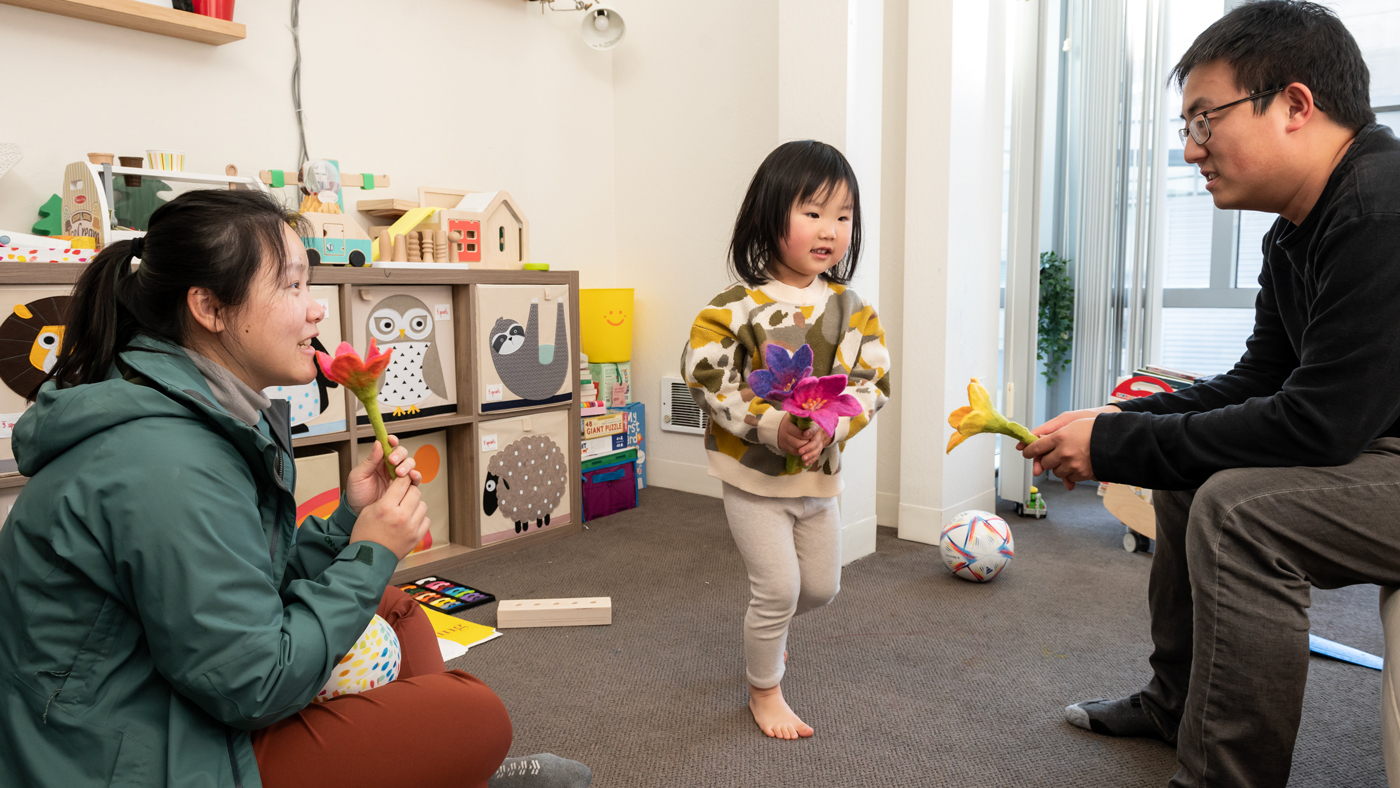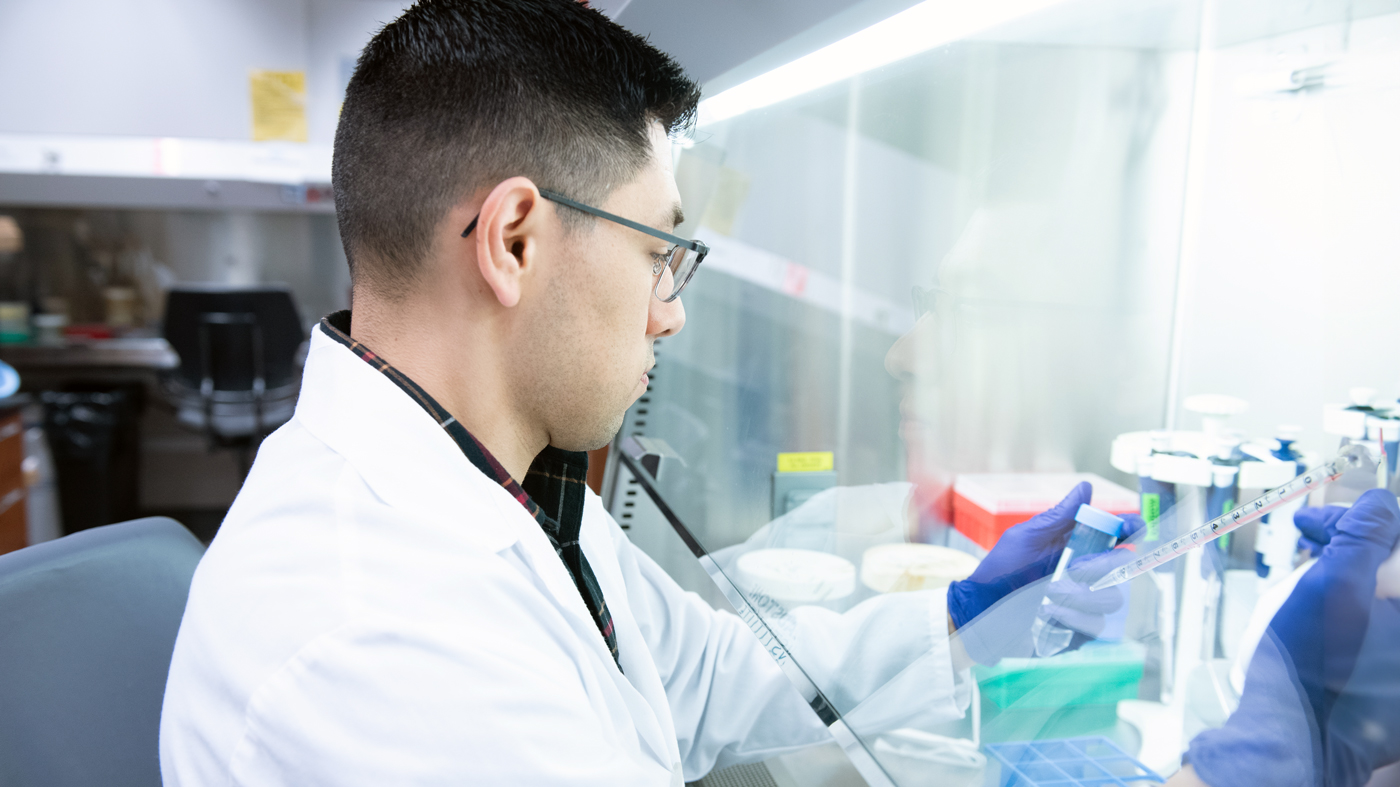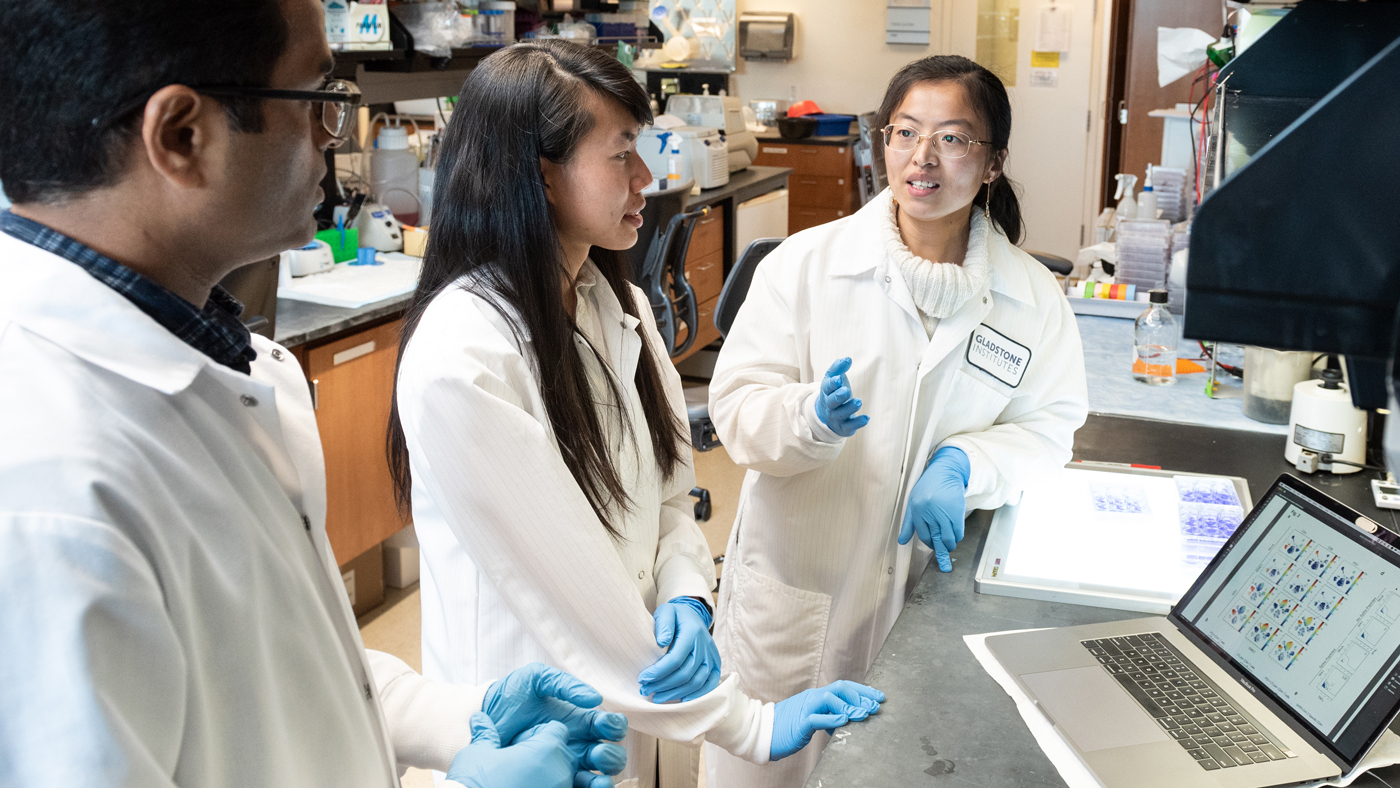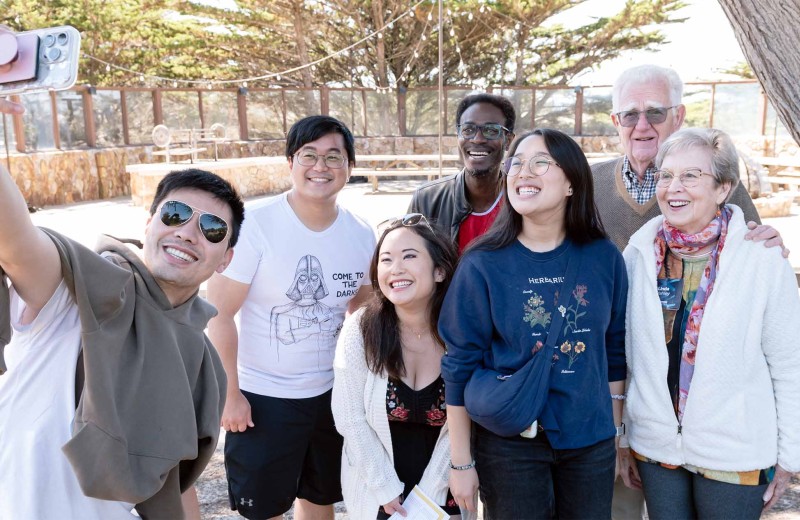Gladstone NOW: The Campaign Join Us on the Journey✕

Gladstone provides additional support to postdocs, particularly those with children—like Zhaoqi Yan, seen here with his daughter Luna.
Shijie Wang, PhD, and Zhaoqi Yan, PhD, met in grad school at the University of Alabama, Birmingham, and got married. They graduated on the same day, and both found positions as postdoctoral scholars at Gladstone Institutes around the same time. In November 2019, approximately 2 months before moving to San Francisco, their daughter Luna was born.
“We joined Gladstone just before the pandemic,” says Yan, who is a postdoc in Katerina Akassoglou’s lab. “We had heard about the cost of living here being high, but it’s only after we moved that we realized how high it actually was.”
The couple moved to the Bay Area to jump-start their scientific careers. But like so many other researchers who choose to train in a large US city—like San Francisco, New York, or Boston—that comes with significant financial challenges, especially when you’re also a parent.

Wang (left) and Yan (right) had their daughter, Luna, only a few months before moving to San Francisco and starting their postdoc at Gladstone. They quickly realized how high the cost of living and childcare are in the city.
To help relieve some of these challenges, Gladstone has put together a comprehensive set of benefits for postdocs—ranging from health and retirement benefits to childcare assistance and a transportation subsidy. And the organization continues to find ways to add even more.
“Postdocs are the engines of discovery in so many labs, so we want to help them as much as we can,” says Sudha Krishnamurthy, PhD, director of Postdoctoral and Graduate Student Education and Research Development at Gladstone. “We recognize that living in San Francisco comes with its own set of obstacles, and we are constantly exploring new and creative ways to support them.”
That’s why, in January 2023, Gladstone increased the postdoc salary scale, which now starts nearly $8,000 per year above the salary recommended by the National Institutes of Health. It also introduced a new housing supplement, providing an additional $10,000 per year to each postdoc.
A Postdoc Life
Being a postdoc isn’t easy.
After completing their PhD, these scientists work in a lab, receiving top-tier research training while making important discoveries. In parallel, they explore new areas of study and prepare to launch their own scientific careers. During their postdoctoral training, researchers need to meet specific milestones, such as publishing scientific papers, presenting at conferences, and writing grants to obtain funding.
“At the same time, they are training to be independent thinkers, creative scientists, and the next generation of leaders,” explains Krishnamurthy. For many postdocs, these crucial milestones often overlap with the timing to start their families.
One of Yan’s lab mates, Andrew Mendiola, PhD, joined the Akassoglou Lab as a postdoc in 2017. In his third year at Gladstone, he and his wife Kristen had their son, Lucas.

Mendiola and his wife had a child in the third year of his postdoc.
“As I became a postdoc, I knew my wife and I were ready to have a child,” says Mendiola. “It’s challenging to do a postdoc—and doing it in the Bay Area is hard financially. When we had our child, that added another layer of complexity. Although it was a beautiful time, we knew we had new challenges ahead of us.”
The Financial Realities of Living in San Francisco
In September 2023, the average monthly rent for a one-bedroom apartment in San Francisco was $2,995. And, the median cost for toddler center-based care is $21,821 per year in the city. That can amount to a large portion of anyone’s paycheck.
“While Gladstone pays postdocs 15 percent more than the federal government and many public universities, training wages in academia have not kept pace with increases in the cost of living,” says Krishnamurthy.
To offset the cost of living in the Bay Area and provide overall support, Gladstone also offers postdocs a full benefits package, including health insurance for them and their families, a retirement plan that is fully vested at all times, family planning benefits, and a monthly transportation subsidy. New postdocs also receive a one-time $5,000 relocation allowance when they join.
What’s more, postdocs with children can receive $5,000 per year for childcare costs, as well as heavily subsidized backup childcare to find last-minute support for sickness and school closures.
“Gladstone provides so many extra benefits to support trainees—that was a big incentive for us to come here.”
And this, in part, is what drew Yan to the organization.
“Gladstone provides so many extra benefits to support trainees—that was a big incentive for us to come here,” says Yan.
“These benefits have really made a difference because the past few years were probably the hardest for us,” adds Yan. “Not only because our daughter transitioned to a preschool, which is more expensive, but also because inflation really took a toll on us. I’m grateful that Gladstone helps my family—without this support, it feels like it would have been impossible for us to get through it.”
Keeping Women—and Mothers—in Science
Tongcui Ma, PhD, is a postdoc in Nadia Roan’s lab. She began her graduate studies in China, then transferred to Philadelphia as an exchange student to obtain her PhD in virology and immunology. At Gladstone, she’s working to identify what makes the HIV virus, hidden inside cells, rebound after people stop taking antiviral drugs. She’s trying to help find a cure for the more than 38 million people living with HIV across the globe.
She’s also a mom to her 4-year-old son Allen and 2-year-old daughter Olivia, and her husband Liang is completing his postdoc at Stanford University.
“We have to send both our kids to a childcare center,” says Ma. “For two kids under age five, we needed to pay $6,000 per month for a place close to my work in San Francisco. My first reaction was that, on two postdoc salaries, we cannot afford this because we need to pay for rent. If we did, we would have no money left for food.”

Ma (right)—seen here with her lab mates Rahul Suryawanshi (left) and Irene Chen (center)—is a scientist and a mother, trying to balance both worlds.
Ma and her husband recently relocated to Palo Alto, 35 miles south of San Francisco, to find a subsidized daycare center charging $4,000 per month instead. The support she received from Gladstone had a significant impact on her family.
“When we moved, we still needed to pay one month’s rent at our previous apartment, plus the rent at our new apartment, all in the same month,” she explains. “It’s a struggle for us to find extra money, and I was very worried about it. The grant we received from Gladstone was really helpful, and got us through that hard time.”
This support might have done more than just help Ma pay for rent. It might also have contributed to keeping her in the lab.
Studies have shown that 43% of women leave full-time STEM employment after having children. Without adequate support through the parenting experience, many postdocs are forced to consider leaving science in order to care for their children.
Ma came close to being part of this statistic.
“For a while, I was thinking it might be best if I quit work and just took care of my children, and maybe once they went to school, I could come back to science.”
“After having kids, I found it very challenging because childcare is so expensive here,” she says. “For a while, I was thinking it might be best if I quit work and just took care of my children, and maybe once they went to school, I could come back to science. But I realized I may never have another chance to get a job in science, so for now, I decided to stay. I’m trying my best to balance life and work.”
From Gladstone’s perspective, it’s critical to find ways to support the people—like Ma—who are moving science forward. Without them, the prospects for better cures and treatments for the most devastating diseases would simply vanish.
“We have always believed in the importance of empowering our early-career scientists to be successful in whatever they want,” says Krishnamurthy. “We don’t want postdocs to have to choose between staying in science or having to support a family—the cost is too high, both for the families and for the scientific enterprise. Our goal is to provide additional support and funding that can empower them to make their own choice.”
Carving a Bright Future for Promising Postdocs
Wang joined Steve Finkbeiner’s lab at Gladstone to apply machine learning to biology. And Yan joined Akassoglou’s lab in large part because she’s a leading expert in neuroimmunology and neurovascular diseases—his area of interest.
“It’s very funny that once we decided to come to San Francisco, my husband and I actually both found a position in the same building,” Wang says.
“I’ve always loved science because it gives me the freedom to explore,” Yan says. “But the more I got into it, the more I saw the potential impact my work can have. One day, what I study could be translated into a medicine and benefit patients—that’s really motivating.”
For Yan, conducting research in the San Francisco Bay Area is really important.
“The beauty of being here is that you’re not only doing science, but you’re probably doing some of the best science in the world,” he says. “I think that’s why people still want to come here, even though the cost of living is high. There’s just too much for us to lose if we don’t live here.”
The Bay Area is, indeed, rich with opportunity: great universities and research institutions where you can train, a thriving biotech and pharmaceutical industry where you can find a future job, and a solid infrastructure to launch a start-up company if your science leads to an exciting potential treatment. Plus, add the beautiful weather, the cultural diversity, and the delicious food, and you have a place coveted by many young adults.
As both Yan and Wang are reaching the middle point of their postdoc, these opportunities provide promising prospects for them both to find a job in science.

In the lab, Wang is applying machine learning to biology.
Mendiola, for his part, has known since his junior year as an undergrad that he wanted to become an academic. That’s when he worked in a research lab for the first time, and it opened his eyes to the excitement and potential of doing science as a career, he says.
“I was the first in my family to go to college,” he shares. “Before that experience, I had no idea that being a researcher or a professor was even a job people could have.”
He was drawn to the autonomy that comes with that career; as long as you can obtain grants to fund your research, you can study whatever you want.
“I felt like there was a lot of power in that,” explains Mendiola. “Being able to choose a career where you could answer unknowns in biology that can help translate to new medicines to treat patients, it seemed like such an exciting thing to do.”
His goal has been to start his own lab to develop new ways to prevent damaging immune responses in the brain that are associated with neurological diseases, such as multiple sclerosis and Alzheimer’s disease. That’s why he moved to San Francisco from his hometown of San Antonio, Texas, after his PhD.
“I was excited to come to the Akassoglou Lab at Gladstone, because I knew it was a place doing cutting-edge science, with leaders in my field who are passionate about their research and mentorship,” he says. “You’d be hard pressed to find as good a place to do a postdoc. Gladstone is really unique, in that everybody wants each other to thrive and succeed.”

Mendiola—seen here mentoring PUMAS Intern Kissanet Frezghi—has always wanted to run his own lab. He recently completed his postdoc at Gladstone and will soon start a professor position at UC San Diego.
In 2022, Mendiola received a Pathway to Independence Award (K99) grant from the National Institutes of Health, which is intended to facilitate the transition of outstanding postdocs to independent faculty positions and research careers.
In September 2023, he completed his postdoc and accepted a new position as assistant professor at UC San Diego. He says that funding, like the childcare grants he received at Gladstone, really opens new doors for scientists like him and allows them to pursue their dream career.
“I knew I had the drive needed to reach my goals if I was in the right environment, and received the right support,” he says. “I really enjoyed my time in the Akassoglou Lab at Gladstone, and despite the financial challenges of living in the Bay Area, I would do it again for sure.”
Want to Join the Team?
Our people are our most important asset. We offer a wide array of career opportunities both in our administrative offices and in our labs.
Explore CareersMeet Gladstone: Oscar Yip
Meet Gladstone: Oscar Yip
Oscar Yip is advancing Alzheimer’s research in Yadong Huang’s lab at Gladstone while drawing inspiration from his family, community, and his broader goal of helping patients.
Graduate Students and Postdocs Profile Alzheimer’s DiseaseFrom Mentorship to Legacy: Creating Opportunity for Early Career Scientists
From Mentorship to Legacy: Creating Opportunity for Early Career Scientists
Robert and Linda Mahley’s commitment to trainee development continues through Gladstone’s annual Career Advancement Awards.
Graduate Students and Postdocs HistoryWhen Brain Cells Talk: NOMIS-Gladstone Fellow Yuliya Voskobiynyk on Decoding Microglia’s Secret Signals
When Brain Cells Talk: NOMIS-Gladstone Fellow Yuliya Voskobiynyk on Decoding Microglia’s Secret Signals
NOMIS–Gladstone Fellow Yuliya Voskobiynyk, PhD, shares her journey from Ukraine to Gladstone and how her research on microglia could shed light on brain function and diseases like epilepsy and Alzheimer’s.
Graduate Students and Postdocs Profile Neurological Disease NOMIS



